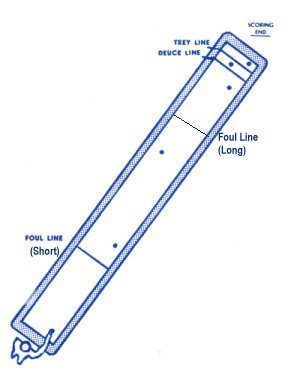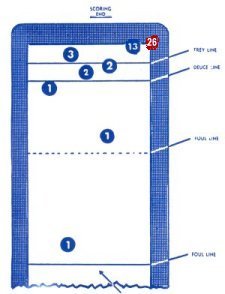|
|
| |
|
|
 |
|
Table Shuffleboard games
are loved by all ages!!! |
There was a time
when table shuffleboard games were loved only by the
players, not operators, or location owners. The game was
thought of as an "older person's
game" or an "expensive bar table." Often times table
shuffleboard is confused with "deck/floor"
shuffleboard where players push a stick on the ground to
get their puck to the scoring area on a floor/deck
court. Times have
changed! Table shuffleboard has become a
competitive and growing sport amongst players of all
ages. With
the success of Sports Bars, Brewery Restaurants and
Family Fun Centers, table shuffleboard has caught on
with players of all ages. In addition, many
shuffleboard players are putting these
shuffleboards in their own homes. The games involve
skill and, of course, a little luck. FUN FOR ALL
AGES to play!
| How
To PLAY and SCORE "Baseball" !!! |
There
are several traditional table shuffleboard games that
are played. The most common table shuffleboard
game played in major tournaments is called "Knock Off". Other
commonly played table shuffleboard games are "Crazy
Eight"
and "Horse Collar"
. "Target"
& "Tap & Draw"
and "Baseball (a Horse
Collar variation)" are less commonly played
games.
Overview
(Baseball:
a "Horse Collar" variation)
Baseball
is one of the many variations of Horse Collar, as
described below. Baseball is played and scored exactly
like Horse Collar, except that the scores are totaled
and a winner named after nine innings (rounds) of play,
rather than when one player or team has reached the
arbitrary total of 51 points.
Overview (Horse Collar)
Games can
be played one-on-one (2 players) or with two or more teams
of two players per team, playing on same end of the
board. Each player/team uses one set of weights [red
or blue]. Depending upon the number of
players, teams may need to alternate ends as the
frames change. Games are played in frames until one team
scores 51-points. However, scoring 51-points
first does not necessarily make that team the winner.
Every team gets to finish each frame and the highest score
is the winner. If the team that scores 51-points or more
has the hammer (the last team to play), then they are
declared the winners. Before a team can score any points
at all, at least one weight must be 3-points or more.
Weights are considered in play if they are on the board
and past the designated foul line [which typically is the
"short" foul line nearest to the player's end of
the board]. It is important to know before the game
starts which foul line has been designated, but typically
it will be the "short" foul line nearest to the
player that is shooting.
If playing
singles, one player will throw all eight weights. If
playing teams (4 or 8 players), one player will throw 4
weights of the same color, then the other player will
throw the remaining 4 weights. The objective is to get at
least one weight into the 3-point or more zone to get the
scoring started. You may bump or tap weights to accomplish
this or simply lag one in. All weights must be past the
designated (short or short) foul line or off the
board. If a weight remains on the board that is not
past the designated foul line, no points can be awarded -
but if it is not your last weight, it may be knocked
off. Again, the objective is to get at least one
weight into the 3-point or greater zone [without any
weights short of the designated foul line - again,
typically the "short" foul line], in order for
any points to count. See below for specifics of How
to Play with 2 players or in teams of 4 or 8
players.

How To Play With 2 Players
Players
stand at opposite ends of the board, facing each
other. The first player shoots all 8 weights (4
blue; 4 red) consecutively towards the opposite end of the
board. After all weights have been shot, the score
is counted as shown in below illustration under
"Method of Scoring". Then the board is
cleared and the opponent shoots in the same manner from
the end of the shuffleboard at which he is standing.
Players alternate shooting until one player has scored 51
points (See "Technical Points" - Rule 1 below).
How To Play With 4 or 8 Players
With more
than two persons, Horse Collar is a team game. If
there are 4 players, they divide into teams of 2 each; if
8 players, they divide into teams of 4. To start a
game the opposing teams station themselves at opposite
ends of the shuffleboard - all players of one team
at one end, all their opponents at the other end.
The first team shoots all 8 weights toward the opposite
end at the other end of the board. The first team
shoots all its 8 weights toward the opposite end, with
each member of the team shooting his quota consecutively,
in the following manner:
 |
On a 2-player
team, the first player shoots 4 weights, in a row
and then his partner shoots the remaining 4 weights
of opposite color. |
 |
On a 4-player
team, the first player shoots 2 weights in a row,
and each of his partners in turn shots 2 weights in
a row until all 8 weights have been shot. |
When all 8
weights have been thrown, score is counted as shown below
in "Method of Scoring". Then the opposing
team clears the board and shoots its 8 weights in the same
manner as described above. Teams continue to
alternate shooting until one team has scored 51 points
(See "Technical Points" - Rule 1 below).
How To Count Players/Teams Scores - "METHOD
OF SCORING RULES"
After all 8 weights in a round have been played, it must
first be determined whether at least one weight is
completely in the trey (3)-zone or overhanging the End or
the left or right hand Corner of the shuffleboard playing
field. If there is NO weight in this zone, NO SCORE
OF ANY KIND CAN BE COUNTED, regardless of how many weights
remain on the board.
If there is at least one weight in the
trey (3-point zone) or overhanging the End (13-point
zone) or the left or right hand Corner of the board
(21-point zone), then the score is counted, as follows:
 |
All weights touching or in front of
the deuce line count 1 point. This applies to
the entire area up to the designated foul line
(typically "short" foul line is
designated), but weight must be completely clear of
the designated foul line to count. |
 |
All weights between the deuce line
and the trey line (including any touching the trey
line), count 2- points. |
 |
All weights between the trey line
and the far end of the board count 3-points. |
 |
All weights overhanging the board at
the far end count 13-points (13 point hanger) . |
 |
All weights overhanging the left
and/or right hand corner of the board count
26-points (26-point hanger). Note: Some
establishments or tournament directors may not
include or count the hanging corner any more than a
hanger from the end of board, but most tournaments
will include the 26-point count possibility.
Hanging corner is another item you should be
informed about before you start to play. |
 |
All weights which fall into the
alleys, or do not clear the designated foul line are
dead and do not count. |
SCORE COUNT SUMMARY:
In order to score, a team must have at
least one weight being worth 3-points or more [It does not
have to be the first weights thrown in order to
score]. For example, if a team throws 1 weight worth
3-points and 2 weights worth 2-points and 3 weights worth
1- point and all remaining weights on the board are past
the designated foul line (again, typically
"short" foul line), the team would score
10-points.
Hangers are worth 13-points [hanger being a weight that is
hanging partially off the end of the board].
Hanger on Corners are worth 26-points [weight is hanging
partially off the end and partially off the side of the
board in either corner]. Note: a weight just
hanging only off the side of the board does not have any
special meaning or point value unless it is a 26-point
hanger on one of the two Corners.
Games are played in frames until one team scores
51-points. However, scoring 51-points first
does not necessarily make that team the winner.
Every team gets to finish each frame and the highest score
is the winner (51-points or greater).
If the team that scores 51-points or more has the hammer
(the last team to play), then they are declared the
winners.
OPTIONAL:
Sometimes players will play Horse Collar also having what
is called a "Hickey" count which means every
time a player does not score, it constitutes a
"Hickey", and each player that does not score in
a round puts an agreed upon amount of money into a
"Hickey Jar" (e.g., $.25, $1, $5, etc.)
and the final winner of the game gets the contents of the
Hickey Jar. This is just something that can be done
to make the game more interesting, but may or may not be
part of your agreed upon Horse Collar tournament rules.

Technical
Points
- A game
is NOT complete until player or team which has been
shooting last has taken its LAST TURN AT THE BOARD,
even though the player or team shooting first has
already scored 51-points or more. If both teams
go over 51 points, the one with the FINAL HIGHEST
SCORE IS THE WINNER.
- During
play, no contestant may leave his position to check
the location of weights he or his partners have
played.
- All
weights which do not completely CLEAR the designated
foul line (typically the "short" foul line
nearest to the player shooting are dead weights, but
must not be removed from the board.
- On the
9-ft. and 12-ft. cushion boards (a.k.a. bank boards),
Horse Collar is played and scored exactly the same as
described above, except that each weight played must
first carom off either side cushion on its way to the
scoring areas. On cushion shuffleboards, the
center foul line applies on all foul line rules
(Note: On the 9-ft. BANK-SHOT the "5"
zone is disregarded and anything in that zone is
considered in the trey zone.)
Miscellaneous Rules
(Re:Board Talk Open Rules/Guidelines)
Before a player shoots, the player can dust the board if
dry spots are showing. Note: In tournaments this may
be restricted to the edge of the board or left to the
discretion of the Tournament Director.
Shooters must have one foot behind the playing surface
while they are shooting.
Hitting or shaking the table is never allowed.
|
|
|
|
| |
|
|
| |
|
|
|
Page Last Updated: 12/14/2005 07:31:30 PM |
|
|